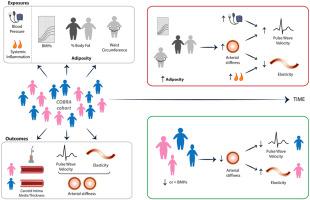Atherosclerosis ( IF 4.9 ) Pub Date : 2021-09-14 , DOI: 10.1016/j.atherosclerosis.2021.09.013 Christoph Saner 1 , Tomi T Laitinen 2 , Joel Nuotio 3 , Sarah J Arnup 4 , Brooke E Harcourt 5 , Siroon Bekkering 6 , Zoe McCallum 7 , Kung-Ting Kao 8 , Marco Janner 9 , Costan G Magnussen 10 , Matthew A Sabin 8 , Markus Juonala 11 , David P Burgner 5

|
Background and aims
Childhood obesity is associated with cardiovascular risk factors (CVRF), subclinical cardiovascular phenotypes (carotid intima-media thickness, cIMT; pulse-wave velocity, PWV; and carotid elasticity), and adult cardiovascular disease (CVD) mortality. In youth with obesity (body mass index, BMI ≥95th centile), we investigated associations between changes in adiposity and CVRF in early adolescence and subclinical cardiovascular phenotypes in late adolescence.
Methods
Participants had adiposity measures (the severity of obesity in percentage >95th BMI-centile (%>95th BMI-centile)), waist circumference (WC), percentage total body fat (%BF) and CVRF (systolic blood pressure, SBP; glycoprotein acetyls, GlycA; and low-density lipoprotein cholesterol) assessed in early (mean age 10.2 ± 3.5y) and late (15.7 ± 3.7y) adolescence. Subclinical cardiovascular phenotypes were assessed in late adolescence. Multivariable regression analysis was performed.
Results
Decreasing the %>95th BMI-centile was associated with carotid elasticity (0.945%/10 mmHg, p = 0.002) in females, and with PWV in males (−0.75 m/s, p < 0.001). Changes in all adiposity measures (per 1-unit increase) were associated with carotid elasticity (−0.020 to −0.063%/10 mmHg, p < 0.005), and PWV (0.011–0.045 m/s, p < 0.005). Changes in GlycA (per 50mol-increase) were associated with elasticity (−0.162%/10 mmHg, p = 0.042), and changes in SBP (per 10 mmHg-increase) were associated with PWV (0.260 m/s, p < 0.001). Adjusted for change in BMI, the coefficient for GlycA was reduced by 46% and for SBP by 12%. Only male sex was associated with cIMT (+34 m, p = 0.006).
Conclusions
In youth with obesity, decreasing or maintaining the severity of obesity, and decreasing the levels of SBP and GlycA from early to late adolescence was associated with low arterial stiffness.
中文翻译:

青春期肥胖严重程度的适度降低与低动脉僵硬度有关
背景和目标
儿童肥胖与心血管危险因素 (CVRF)、亚临床心血管表型(颈动脉内膜中层厚度,cIMT;脉搏波速度,PWV;和颈动脉弹性)和成人心血管疾病 (CVD) 死亡率相关。在肥胖青年(体重指数,BMI ≥ 95th 百分位)中,我们调查了青春期早期肥胖变化与 CVRF 与青春期晚期亚临床心血管表型之间的关联。
方法
参与者进行了肥胖测量(肥胖的严重程度百分比 > 95th BMI-centile (%>95th BMI-centile))、腰围 (WC)、全身脂肪百分比 (%BF) 和 CVRF(收缩压,SBP;糖蛋白)在青春期早期(平均年龄 10.2 ± 3.5 岁)和晚期(15.7 ± 3.7 岁)进行评估。在青春期后期评估亚临床心血管表型。进行了多变量回归分析。
结果
降低 %>95th BMI 百分位数与 女性的颈动脉弹性 (0.945%/10 mmHg, p = 0.002) 和男性的 PWV (-0.75 m/s, p < 0.001) 相关。所有肥胖指标的变化(每增加 1 个单位)与颈动脉弹性(-0.020 至 -0.063%/10 mmHg,p < 0.005)和 PWV(0.011-0.045 m/s,p < 0.005)相关。GlycA 的变化(每 50mol 增加)与弹性相关(-0.162%/10 mmHg,p = 0.042),SBP 的变化(每增加 10 mmHg)与 PWV 相关(0.260 m/s,p < 0.001)。根据 BMI 的变化调整后,GlycA 的系数降低了 46%,SBP 的系数降低了 12%。只有男性与 cIMT 相关 (+34 米,p = 0.006)。
结论
在肥胖青年中,降低或维持肥胖的严重程度以及从青春期早期到晚期降低 SBP 和 GlycA 的水平与低动脉僵硬度有关。











































 京公网安备 11010802027423号
京公网安备 11010802027423号